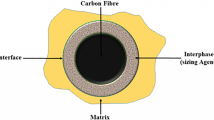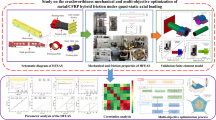Abstract
This study presents a finite-element-method analysis of the bending and thermal shock crack performance of multilayer ceramic capacitors (MLCCs) used in automobiles. The stress, strain, and heat flux values were analyzed for different MLCC structures and material parameters using three-point bending test and thermal shock test simulations. Three-dimensional modeling was performed using the actual design values of an MLCC—1005 size and 1 µF capacitance—and simulations were performed after setting the boundary and analysis conditions for the three-point bending and thermal shock tests. Based on the analyzed simulation results, the stress, strain, and heat flux values applicable to the MLCC were compared and analyzed to determine the optimum modeling parameters that could improve its reliability under harsh environmental conditions. This study was able to confirm the structural stress and strain changes, and the results were found to be useful to optimize the design of automotive MLCC devices.











Similar content being viewed by others
References
Lee SP, Kang KW (2018) Analysis for deformation behavior of multilayer ceramic capacitor based on multiscale homogenization approach. J Mech Sci Technol 32(6):2577–2585
Samantaray MM et al (2012) Electrode defects in multilayer capacitors part i: modeling the effect of electrode roughness and porosity on electric field enhancement and leakage current. J Am Ceram Soc 95(1):257–263
Chen K-Y et al (2014) Control of stress concentration in surface-mounted multilayer ceramic capacitor subjected to bending. J Am Ceram Soc 97(4):1170–1176
Al Ahmar J, Wiese S (2016) Crack experiments on multilayer ceramic capacitors and fracture mechanics analysis. In: 2016 17th international conference on thermal, mechanical and multi-physics simulation and experiments in microelectronics and microsystems (EuroSimE). p. 1–5
Al Ahmar J, Wiese S (2015) A finite element modelling and fracture mechanical approach of multilayer ceramic capacitors. In: 2015 16th international conference on thermal, mechanical and multi-physics simulation and experiments in microelectronics and microsystems. 2015, p. 1–5
Lee SP et al (2013) Numerical analysis of dielectric ceramic and void containing Ni electrode layers of multilayer ceramic capacitors. J Compos Mater 47(13):1593–1604
Scott GC, Astfalk G (1990) Thermal stresses in multilayer ceramic capacitors: numerical simulations. IEEE Trans Compon Hybrid Manuf Technol 13(4):1135–1145
Keimazi M, Azarian MH, Pecht M (2007) Isothermal aging effects on flex cracking of multilayer ceramic capacitors with standard and flexible terminations. Microelectron Reliab. 47(12):2215–2225
Haiyu Q et al. (2005) Effects of printed circuit board materials on lead-free interconnect durability. In: Polytronic 2005–5th international conference on polymers and adhesives in microelectronics and photonics. IEEE, p. 140–144.
Xing J, Radovic M, Muliana A (2016) Thermal properties of BaTiO3/Ag composites at different temperatures. Compos Part B Eng 90:287–301
Majcherek S et al (2015) Silicon based in-situ measurement system for flex loads on MLCCs in PCB manufacturing chain. Sens Actuators A Phys 233:267–274
Mark Stewart, Coleraine, Northern Ireland (2018) AVX MLCC FlexiTermTM: guarding against capacitor crack failures. In: AVX Technical Paper
Kang M-S et al (2016) Degradation characteristics and Ni 3 Sn 4 IMC growth by a thermal shock test in SAC305 solder joints of MLCCs applied in automotive electronics. Int J Precis Eng Manuf 17(4):445–452
Chan YC et al (1995) Nondestructive detection of defects in miniaturized multilayer ceramic capacitors using digital speckle correlation techniques. IEEE Trans Compon Packaging Manuf Technol Part A 18(3):677–684
Blattau N, Barker D, Hillman C (2004) Lead free solder and flex cracking failures in ceramic capacitors. In: Carts-Conference-. Components Technology Institute Inc., 2004, p. 101
Engel GF et al. (2006) Effective reduction of leakage failure mode after flex cracking events in X7R-type multilayer ceramic capacitors (MLCCs) by using internal series connection (MLSCs). EPCOS OHG, Ceramic Multilayer Technology. In: Proceedings of the CARTS Europe, Bad Homburg, Germany, 2006
Huang H, Spaepen F (2000) Tensile testing of free-standing Cu, Ag and Al thin films and Ag/Cu multilayers. Acta Mater 48(12):3261–3269
Jung S-W et al (2016) A study on the degradation characteristics of MLCCs SAC305 lead-free solder joints and growth IMCs by thermal shock test. J Korea Inst Electr Electron Mater Eng 29(3):152–158
Kang M-S et al (2016) Degradation characteristics and Ni3Sn4 IMC growth by a thermal shock test in SAC305 solder joints of MLCCs applied in automotive electronics. Int J Precis Eng Manuf 17(4):445–452
Lee C-S et al (2009) Investigation and analysis of cracks in multi-layer ceramic capacitor. J Korea Ceram Soc. 46(2):swdere211
Author information
Authors and Affiliations
Corresponding author
Additional information
Publisher's Note
Springer Nature remains neutral with regard to jurisdictional claims in published maps and institutional affiliations.
Rights and permissions
About this article
Cite this article
Lee, CH., Yoon, JR. Design and FEM Analysis of Multilayer Ceramic Capacitors with Improved Bending and Thermal Shock Crack Performance. J. Electr. Eng. Technol. 16, 2141–2148 (2021). https://doi.org/10.1007/s42835-021-00712-w
Received:
Revised:
Accepted:
Published:
Issue Date:
DOI: https://doi.org/10.1007/s42835-021-00712-w




